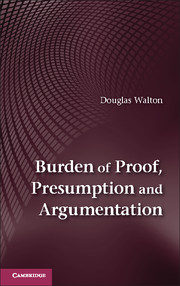Book contents
- Frontmatter
- Dedication
- Contents
- Acknowledgments
- 1 Introduction to Basic Concepts and Methods
- 2 Burdens of Proof in Legal Reasoning
- 3 Presumption in Legal Reasoning
- 4 Shifting the Burden of Proof in Witness Testimony
- 5 Burden of Proof in Dialogue Systems
- 6 Solving the Problems of Burden of Proof
- 7 Burdens of Proof in Different Types of Dialogue
- 8 Conclusions
- Bibliography
- Index
6 - Solving the Problems of Burden of Proof
Published online by Cambridge University Press: 05 July 2014
- Frontmatter
- Dedication
- Contents
- Acknowledgments
- 1 Introduction to Basic Concepts and Methods
- 2 Burdens of Proof in Legal Reasoning
- 3 Presumption in Legal Reasoning
- 4 Shifting the Burden of Proof in Witness Testimony
- 5 Burden of Proof in Dialogue Systems
- 6 Solving the Problems of Burden of Proof
- 7 Burdens of Proof in Different Types of Dialogue
- 8 Conclusions
- Bibliography
- Index
Summary
Erik Krabbe’s pioneering article on metadialogues (dialogues about dialogues) opened up an important new avenue of research in the field, largely unexplored up to that point. His modest conclusion was that it was too early for conclusions (Krabbe, 2003, 89). Even so, by posing a number of problems along with tentative solutions, his article was a very important advance in the field. Hamblin (1970) was the first to suggest the usefulness of metadialogues in the study of fallacies. He proposed (1970, 283–284) that disputes that can arise about allegations that the fallacy of equivocation has been committed could be resolved by redirecting the dispute to a procedural level. This procedural level would correspond to what Krabbe calls a metadialogue (Krabbe, 2003). Other writers on argumentation (Mackenzie, 1979, 1981; Finocchiaro, 1980, 2005; van Eemeren and Grootendorst, 1992), as noted by Krabbe (2003, 86–87) have tacitly recognized the need to move to a metalevel dialogue framework, but none provided a metadialogue system. The study of metadialogues is turning out to be very important in argumentation theory and in computer science (Wooldridge, McBurney and Parsons, 2005).
In Chapter 6, it is shown how analyzing disputes about burden of proof is an important research topic for investigation in the field of metadialogue theory. It has recently been shown (Prakken, Reed and Walton, 2005) that legal disputes about burden of proof can be formally modeled by using the device of a formal dialogue protocol for embedding a metadialogue about the issue of burden of proof into an ongoing dialogue about some prior issue. In Chapter 8, a general solution to the problem of how to analyze burden of proof is yielded by building on this framework, using three key examples from Chapter 1 to show how disputes about burden of proof can arise. These three examples were presented in Chapter 1 as classic cases of burden of proof disputes, and now in Chapter 6 it is shown how current tools from argumentation theory and artificial intelligence based on metadialogues can be applied to the problems they pose.
- Type
- Chapter
- Information
- Burden of Proof, Presumption and Argumentation , pp. 176 - 210Publisher: Cambridge University PressPrint publication year: 2014



